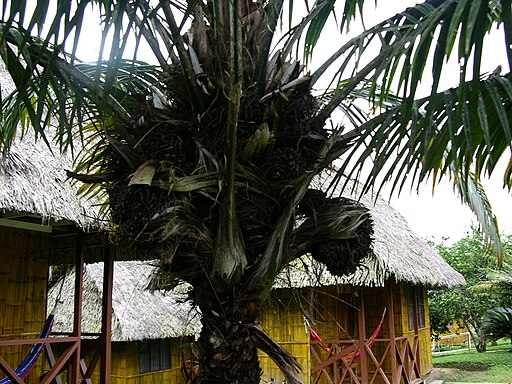Classification System: APG IV
Superregnum: Eukaryota
Regnum: Plantae
Cladus: Angiosperms
Cladus: Monocots
Cladus: Commelinids
Ordo: Arecales
Familia: Arecaceae
Subfamilia: Ceroxyloideae
Tribus: Phytelepheae
Genus: Phytelephas
Species: Phytelephas aequatorialis
Name
Phytelephas aequatorialis Spruce
References
Journal of the Linnean Society. Botany. London 11:179. 1871
USDA, ARS, Germplasm Resources Information Network. Phytelephas aequatorialis in the Germplasm Resources Information Network (GRIN), U.S. Department of Agriculture Agricultural Research Service. Accessed: 08-Apr-12.
The palm tree Phytelephas aequatorialis, commonly known as Ecuadorian ivory palm, is the main source of Ecuadorean vegetable ivory or tagua, a botanical alternative to ivory. It is found in the tropical rainforests of the western Andean slopes of Ecuador. It has a woody trunk which can grow to 20 m in height and very long pinnate leaves.
Description
The plants are dioecious, with the female individuals bearing large brown conical fruits, each approximately the size of a grapefruit and covered in a horned husk, containing usually four seeds. Immature seeds contain sweet edible pulp. Mature seeds are harder than wood and are encased in a bonelike shell. The endosperm is a white hemicellulose material that is so hard it can be polished and carved like ivory. (The plant's genus name Phytelephas means "elephant plant".) Three other species in this genus are sources of vegetable ivory as well.
Animal consumption
The edible immature seeds are often dispersed by rainforest rodents such as agoutis. In some rural areas the trees are used to attract rodents, which are then captured for their meat.
Animals that feed on the fleshy mesocarp of the palm's fruit include squirrels (Sciurus aestuans), agoutis (Dasyprocta spp.), deer (Odocoileus virginianus), opossums (Marmosa spp.), porcupines (Coendou spp.), and (Cuniculus paca).[2]: 70
Cultivation
The palms are occasionally cultivated as a cash crop. International conservation organizations pay farmers for vegetable ivory in hopes that interest in the product will lead to resources being allotted for the protection of rainforests and the preservation of its flora.
Due to its commercial usefulness, the trees were usually preserved when rainforest was cleared for agricultural use.[2]
See also
Vegetable ivory
References
Montúfar, R.; Pitman, N. (2003). "Phytelephas aequatorialis". IUCN Red List of Threatened Species. 2003: e.T43981A10836113. doi:10.2305/IUCN.UK.2003.RLTS.T43981A10836113.en. Retrieved 13 November 2021.
Brokamp, Grischa (2015). Relevance and Sustainability of Wild Plant Collection in NW South America: Insights from the Plant Families Arecaceae and Krameriaceae. Wiesbaden: Springer Spektrum. doi:10.1007/978-3-658-08696-1. ISBN 978-3-658-08695-4. S2CID 30557398.
Retrieved from "http://en.wikipedia.org/"
All text is available under the terms of the GNU Free Documentation License


